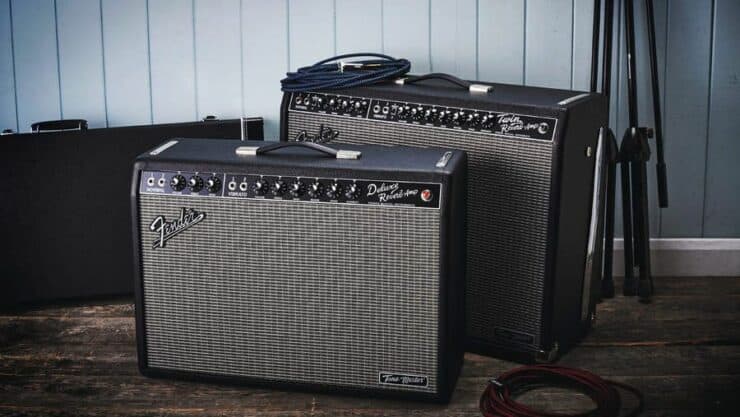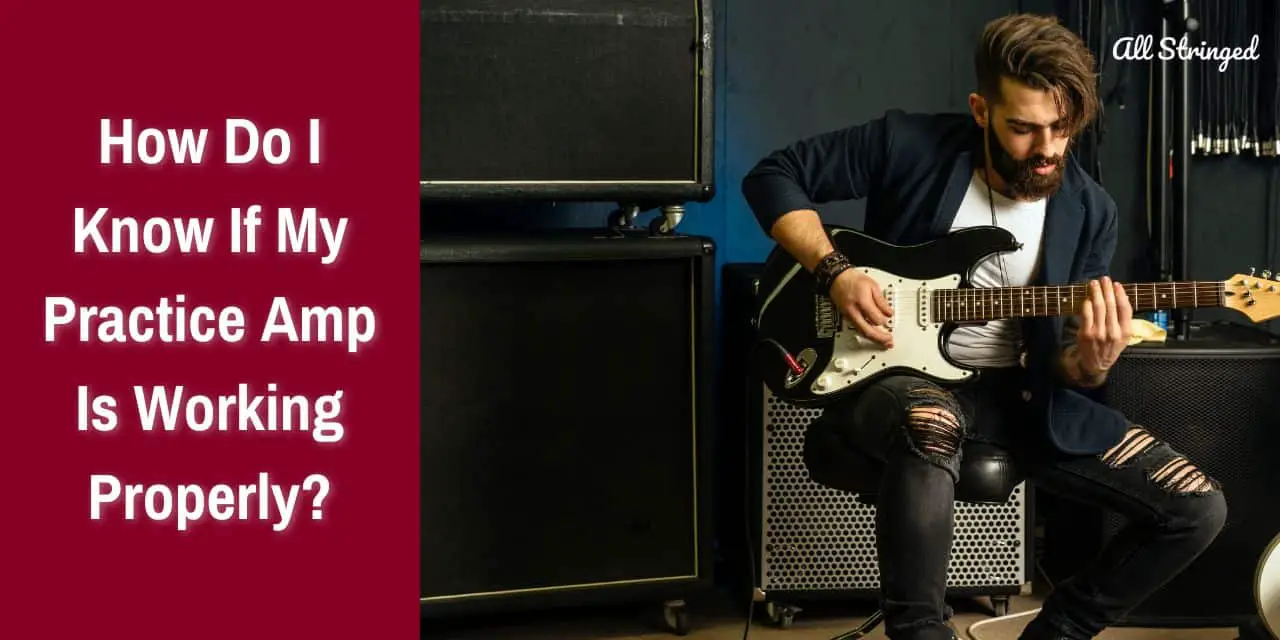Have you ever noticed that your practice amp just doesn’t sound quite right? Unsure whether it’s something wrong with the amp or if you’re just not playing correctly? Don’t worry, in this article we’ll discuss the basics of practice amp maintenance and how to determine whether your amp is working properly. Guitar players, get ready to learn all about practice amp maintenance and how to make sure you’re getting the most out of your practice amp.
What to look for in a practice amp?
A practice amp is an essential tool for any guitarist, especially for novices and beginners who want a reliable and affordable option for practicing and honing their skills. When it comes to practicing guitars, having the right gear could make all the difference in the world. A great practice guitar amp will help you hear what you’re playing more clearly, experiment with different sounds, and inspire yourself to new heights of creativity. With so many options like Marshall, Fender, Boss, Blackstar, and more available in the market, it can be tricky to know what to look for in a practice amp. Here is what to look for in a practice amp –
#1. Portability
The portability of your practice amp matters, especially if you intend to carry it around for jamming sessions and gigs. Smaller amps are much more portable and convenient, whereas the larger ones have more features and better sound quality. You should consider your needs and where you will be using the amp more frequently for determining the ideal size.
#2. Power rating
The power rating of a practice amp is one of the most important factors that you need to look for when choosing a practice amp. The power rating will determine the overall volume and headroom of the amp. The power of a practice amp is measured in watts, and it determines exactly how loud the amp can get. For practice amps, 10W or 20W will be sufficient for most guitarists, especially the ones who largely practice at home. If you intend to play with other people in large spaces, you will need more power.
ALSO READ: Best Practice Amp: Top 7 Picks to Play Anywhere!
To test the power rating of the amp, you can begin by turning the volume up to a comfortable level and playing a few chords. If the amp sounds too distorted or muddy at a low volume, it might not have enough headroom for your playing style.
#3. Speaker size
The size of the speaker in your practice amp will also affect how it sounds. Larger speakers typically produce more low-end and have a fuller sound, while smaller speakers can be more focused and articulate. For a practice amp, having an 8 to 10 inch speaker will be usually sufficient.
#4. Tone controls
Tone controls will allow you to shape the sound of the guitar amp. You should look for an amp that has bass, mid, and treble controls so that you can adjust the EQ to your liking. Some amps also come with a “presence” control, which can add clarity and definition to the sound.

#5. Effects
Many practice amps come with built-in effects like chorus, reverb, and distortion. While they can be quite fun to play around with, they might not be essential for your practice needs. You must consider whether you really require these effects, or if you would be better off with a simpler amp.
#6. Connectivity
Lastly, you should think of what sort of connectivity options you want in your practice amp. Most amps come with a standard ¼ inch input for your guitar, but you might also want an aux input such that you can play along with backing tracks or music from your phone. Some amps also come with headphone jacks, which can be a wonderful feature if you want to practice quietly.
#7. Sound quality
The sound quality of an amp will be crucial, especially for practice sessions where you’ll want to hear the nuances of your playing. You should look for an amp that has a clear and balanced tone, which allows you to hear the highs, mids, and lows of your guitar.
#8. Price that suits your budget
Practice amps come at different price points, from budget-friendly options to high-end models. You should determine your budget and look for a practice amp that offers the best value for your money. You should not sacrifice on the price, but you should not overspend on features that you won’t be using either.
#9. Brand and reputation
It is a smart idea to purchase a practice amp from a reputable brand with a history of producing quality amps. You must remember to check the reviews and testimonials from other users to determine which brands are reliable and offer the best value for money.
Ultimately, the right practice amp for you will depend on your specific needs and preferences. Considering factors like power, price, sound quality, and more can help you narrow down your options and help you find an amp that helps you achieve the best sound.

How to test a practice amp?
A practice amp is a great tool in the arsenal of a guitarist. It will help you refine your skills and develop your sound. However, to get the most out of your practice amp, you’ll want to test your practice amp to see how well it performs. Here is how you can test your practice amp –
#1. Listen to sound samples
One of the easiest ways of testing a practice amp will be to listen to sound samples online. Most music stores have websites where they post sound clips of different amps being played. This can give you a general idea of the sound quality of the am. You can listen to multiple amps and compare them side by side. It is important to keep in mind that the sound quality you hear on your phone or your computer might not be the same as what you hear in person. However, it will still be a decent starting point.
#2. Test the amp in person
If possible, it’ll be best if you test the amp in person. This will give you a great chance of hearing the sound quality in real time and knowing how it feels to play through the amp. When you’re hearing an amp in person, you should try to bring your own guitar such that you’re able to get a better sense of how the amp works with your guitar.
When testing an amp, you should pay close attention to the volume. You’ll want to ensure that the amp is loud enough for your needs, but also that it is quiet enough to practice in a small space without disturbing others. If you’re playing at home, it is important to consider the volume levels that your neighbors can tolerate.
#3. Experiment with different sounds
Experimenting with different sounds will be important when testing the practice amp. Most amps come with tone controls that allow you to easily adjust the bass, treble, and mid-frequencies. Try to adjust the controls to see how it affects the sound of the guitar. Some amps also come with built-in effects like delay, reverb, and distortion. If you are interested in using these effects, you should ensure that you’re testing them and seeing how they sound.
#4. Checking for distortion
One of the things to keep in mind when testing a practice amp will be distortion. Distortion is a common effect used in rock and metal music, but it can also be a sign of a poor-quality amp. If the amp sounds distorted when playing at higher volumes, it can be a sign that the amp isn’t capable of handling the power or that the speakers aren’t able to handle the volume. It is important that you find an amp capable of handling the power and volume levels that you need without distorting the sound.
#5. Speaker size
The size and quality of the speaker can have a major impact on the overall sound of the amp. For testing the speaker size, you should play a few different samples of music to see how the amp is handling different styles. You can test the practice amp’s speaker by adjusting the EQ settings and seeing how the amp responds.
#6. Tone controls
The tone controls on your practice amp can be a valuable tool for shaping the sound. For testing the tone controls, start off by playing a clean tone and adjusting the bass, treble, and mid to your liking. After that, switch to a distorted tone and adjust the tone controls once more to see how they affect the overall sound.
#7. Connectivity
The connectivity options on a practice amp can be quite important if you intend to use it for recording or playing live. For testing the connectivity options, you should try to connect the amp to your computer or recording device and see how well it performs. You can also test the amp by connecting it to a mixer or PA system and see how it sounds in a live setting. Some amps also come with Bluetooth connectivity, allowing you to play along to backing tracks or stream music wirelessly.
Common problems with practice amps
Aspiring guitarists often buy a practice amp for practicing their skills at home. These small amps are typically designed for personal use and offer a wide range of features to help guitarists refine their playing style. The guitarist can easily experiment with different sounds and practice at various volumes.
However, like any other electronic device, practice amps can experience problems and develop issues that can affect performance. Here are some of the common problems with practice amps –
Faulty wiring
One of the common issues with practice amps is faulty wiring. This can occur because of improper handling, wear and tear, or a manufacturing defect. Signs of faulty wiring could include cracking or popping sounds, intermittent sound, or loss of power. In some cases, the amp may not work at all.
For addressing faulty wiring, it’ll be important to first identify the source of the problem. This might require opening up the amp and inspecting the wiring for any loose connections, frayed wires, or other damage. If the problem is beyond your level of expertise, it’ll be best to take the amp to a professional technician.
Blown speakers
Another common issue with practice amps is blown speakers. This can occur when the amp is played at excessively high volumes or when the amp is overloaded with too much power. Signs of a blown speaker could include distortion, a rattling sound, or no sound at all.
For addressing a blown speaker, the first step would be to confirm that the problem is indeed a blown speaker. This can be carried out by testing the amp with a different set of speakers. If the sound is still absent or distorted, the issue might be with the amp itself. However, if the new speakers produce a clear sound, it is likely that the original speaker is blown and will have to be replaced.
Poor sound quality
Poor sound quality will be another common issue with the practice guitar amps. This can typically occur because of a wide variety of factors, including a damaged tone control circuit, improper equalization settings, and insufficient power.
To address poor sound quality, you should begin by experimenting with different tone settings and equalization settings. Moreover, check the power rating of the amp to make sure that it is sufficient for your needs. If the issue persists, it might be necessary to have the tone control circuit inspected and repaired by a professional technician.
Low volume
One of the common issues with practice amps will be low volume or lack of sound. This can be caused by a wide variety of factors like loose cable, blown fuse, or a faulty speaker.
For troubleshooting the issue, you should check all the cables and connections between the guitar and the practice amp. Make sure that all the cables are plugged in securely and not damaged. If the cables are okay, you should check the speaker by plugging in headphones or a different speaker to the amp. If the speaker is the issue, it might have to be replaced.
Distorted sound and feedback
A distorted sound is an issue that guitarists might encounter with their practice amps. This can be caused by overdriving the amp or a faulty speaker. For resolving the issue, you should reduce the gain on the amp or adjust the volume levels. If the speaker is the problem, it might have to be replaced.
Feedback is essentially a high-pitched whistling sound that occurs when your guitar is too close to the amp. This can be a problem for guitarists playing at high volumes. For preventing feedback, you should try to move the guitar away from the amp or reduce the volume levels. Moreover, using a noise gate pedal can help eliminate feedback.
Humming or buzzing noise
Another problem with practice amps would be the humming or buzzing noise issue. This is typically caused by interference from other electronic devices or a ground loop. A ground loop can occur when there are multiple grounding paths between the guitar, practice amp, and power source, creating an electrical loop. For resolving this issue, you should try to plug the amp into a different power outlet or use a ground loop isolator.
Power issues
Power issues are also a common issue with practice amps. This can be caused by a faulty power supply or a blown fuse. For troubleshooting this issue, you should check the power supply and ensure it is working correctly. If the power supply is the issue, it might have to be replaced.
How to troubleshoot a practice amp
Practice amps are important tools for any guitarist who wants to practice and improve their skills from the comfort of their home. These amps come equipped with a wide range of features that help guitarists refine their playing style. However, like any other piece of equipment, practice amps can help develop issues over time, affecting their performance. There are certain troubleshooting tips to carry out for your practice amp –
#1. Checking the power supply
The first step in troubleshooting a practice amp would be to check the power supply. The power supply will be responsible for providing power to the amp and if it isn’t functioning correctly, the amp will not work.
To check the power supply, you should begin by unplugging the amp from the power source and opening the back panel to access the internal components. Moreover, check the fuse and ensure it isn’t blown. If the fuse is blown, you should replace it with a new one of the same rating.
If the fuse isn’t the issue, use a multimeter for testing the voltage of the power supply. The voltage must match the specifications outlined in the user manual. If the voltage is too high or too low, the power supply might have to be replaced.
#2. Testing the speakers
If the power supply isn’t the issue, the next step would be to test the speakers. A faulty speaker could cause a wide range of issues with the amp’s sound quality, including distorted sound or no sound at all.
For testing the speakers, begin by plugging in headphones and playing through the amp. If the sound is clear through the headphones, the speakers might be the issue. Make use of a multimeter for testing the speakers’ resistance, which needs to match the specifications outlined in the user manual. If the resistance is too low or too high, the speakers might have to be replaced.
#3. Replacing components
If the power supply and speakers aren’t the issues, the next step would be to check the internal components. Over time, components like resistors, capacitors, and transistors can wear out or become damaged. This can cause issues with the performance of the practice amp. For replacing these components, you should start by identifying the faulty components using a multimeter.
Once you have identified the faulty components, remove them from the circuit board and replace them with a new component of the same rating. If you aren’t confident in your ability to replace components, you should consider taking your practice amp to a professional repair technician.
FAQs
What can I do to ensure my practice amp is working properly?
To ensure your practice amp is working properly, it’s important to perform regular maintenance and checks. This includes checking the connections to ensure they are secure, as well as checking the speaker and cables for any signs of damage. Additionally, it’s important to check the settings on the amp and make sure that all the knobs and switches are functioning correctly.
What are some signs that my practice amp may need repairs?
A: If your practice amp is producing distortion, crackling, or buzzing noises, this may be a sign that it needs repairs. Other signs include a lack of sound, lack of volume, or lack of tone control. If you notice any of these issues, it may be a good idea to bring your amp to a qualified technician for repairs.
What should I do if my practice amp is not working as expected?
A: If your practice amp is not working as expected, the first step is to check the connections and settings to make sure everything is properly set up. If the issue persists, it may be a good idea to bring your amp to a qualified technician for repairs. It is also important to check your amp’s warranty to see if any of the repairs may be covered.



